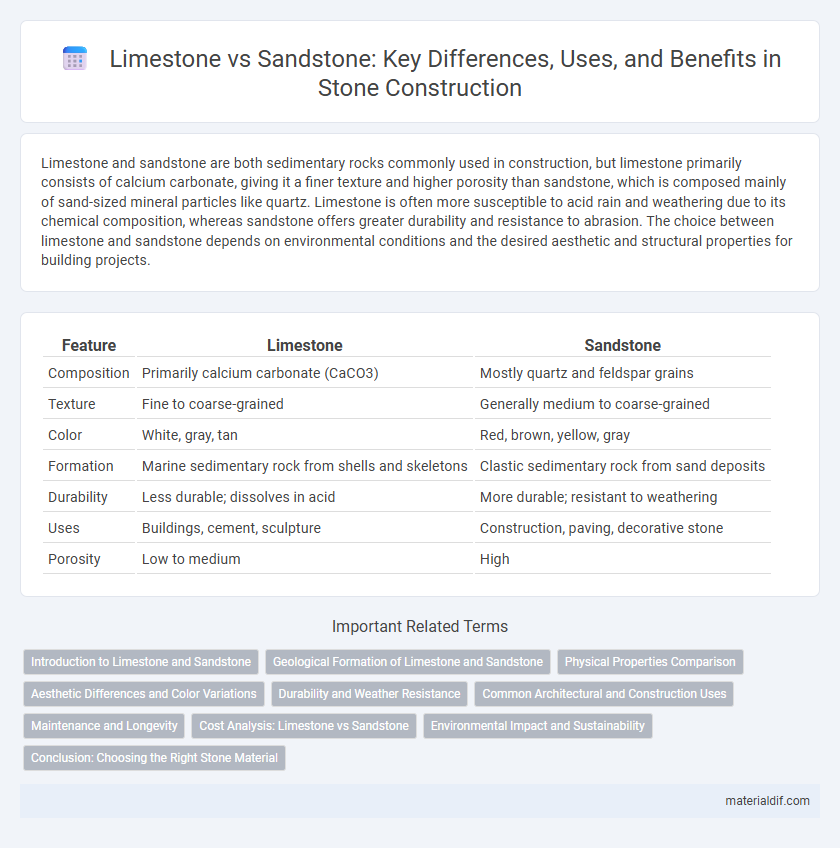Limestone and sandstone are both sedimentary rocks commonly used in construction, but limestone primarily consists of calcium carbonate, giving it a finer texture and higher porosity than sandstone, which is composed mainly of sand-sized mineral particles like quartz. Limestone is often more susceptible to acid rain and weathering due to its chemical composition, whereas sandstone offers greater durability and resistance to abrasion. The choice between limestone and sandstone depends on environmental conditions and the desired aesthetic and structural properties for building projects.
Table of Comparison
| Feature | Limestone | Sandstone |
|---|---|---|
| Composition | Primarily calcium carbonate (CaCO3) | Mostly quartz and feldspar grains |
| Texture | Fine to coarse-grained | Generally medium to coarse-grained |
| Color | White, gray, tan | Red, brown, yellow, gray |
| Formation | Marine sedimentary rock from shells and skeletons | Clastic sedimentary rock from sand deposits |
| Durability | Less durable; dissolves in acid | More durable; resistant to weathering |
| Uses | Buildings, cement, sculpture | Construction, paving, decorative stone |
| Porosity | Low to medium | High |
Introduction to Limestone and Sandstone
Limestone, primarily composed of calcium carbonate, forms through marine organism shells' accumulation and chemical precipitation, featuring a fine to coarse grain texture with a natural white to gray color. Sandstone consists mainly of sand-sized mineral particles or rock fragments, predominantly quartz and feldspar, cemented together, exhibiting variable colors like tan, yellow, red, and brown due to iron oxide and other mineral content. Both stones are widely used in construction and architectural design, with limestone prized for its durability and aesthetic appeal, while sandstone is valued for its porosity and ease of shaping.
Geological Formation of Limestone and Sandstone
Limestone forms primarily through the accumulation and compaction of marine organisms' calcium carbonate shells and skeletal fragments, often in warm, shallow marine environments. Sandstone originates from the lithification of sand-sized mineral particles or rock fragments, typically quartz, deposited by wind, rivers, or oceans. The depositional environment shapes sandstone's grain size and sorting, while limestone's formation is closely linked to biochemical precipitation and sedimentation processes.
Physical Properties Comparison
Limestone is a sedimentary rock primarily composed of calcium carbonate, exhibiting a fine to coarse grain texture with a typically lighter color and relatively low hardness on the Mohs scale, around 3 to 4. Sandstone consists of compacted sand-sized mineral particles, predominantly quartz, offering a rougher texture, greater porosity, and higher hardness rating between 6 and 7. Limestone generally has better resistance to weathering in acidic environments, whereas sandstone tends to be more durable under mechanical stress and abrasion.
Aesthetic Differences and Color Variations
Limestone typically exhibits a smooth, fine-grained texture with colors ranging from soft whites and creams to warm beiges and light grays, lending a classic, elegant appearance to architectural and design projects. Sandstone features a coarser, gritty texture with a broader spectrum of colors including reds, yellows, browns, and tans, creating a rustic or natural aesthetic that is highly sought after for outdoor applications. The distinct color variations in sandstone are often caused by mineral impurities like iron oxide, while limestone's more subtle hues result from its calcite composition.
Durability and Weather Resistance
Limestone exhibits moderate durability with susceptibility to acid rain erosion due to its calcium carbonate composition, whereas sandstone offers higher resistance to weathering, particularly in dry climates, thanks to its tightly packed silica grains. Sandstone's durability is further enhanced by its porosity, which allows for better moisture absorption and drying, reducing freeze-thaw damage. Limestone's softness makes it prone to surface wear and chemical dissolution, impacting long-term structural applications in harsh environments.
Common Architectural and Construction Uses
Limestone is widely used in architectural cladding, flooring, and ornamental features due to its durability and ease of carving, making it ideal for historic restorations and classical facades. Sandstone's natural grain and porosity make it a preferred material for paving, exterior walls, and garden landscaping, offering weather resistance and aesthetic warmth. Both stones serve critical roles in construction, with limestone favored for structural blocks and sandstone employed in decorative and load-bearing elements.
Maintenance and Longevity
Limestone requires regular sealing and careful cleaning to prevent erosion and staining due to its porous nature, making maintenance more intensive compared to sandstone. Sandstone offers greater durability and resists weathering better, resulting in longer lifespan with less frequent upkeep. Both stones benefit from periodic inspections, but sandstone's natural hardness ensures superior longevity in outdoor applications.
Cost Analysis: Limestone vs Sandstone
Limestone typically costs between $50 and $75 per square foot, making it a more affordable option compared to sandstone, which ranges from $60 to $90 per square foot. The installation expenses for limestone are generally lower due to its softer texture, reducing labor time and tool wear. Maintenance costs for sandstone tend to be higher over time because of its porous nature, which can require more frequent sealing and repairs.
Environmental Impact and Sustainability
Limestone extraction typically results in higher carbon emissions due to the energy-intensive calcination process, whereas sandstone quarrying involves less energy but can lead to significant habitat disruption. Limestone's ability to neutralize acidic soils offers environmental benefits, promoting sustainability in agriculture and construction. Sandstone, being more porous and durable, contributes to natural water filtration but requires careful management to prevent extensive landscape degradation.
Conclusion: Choosing the Right Stone Material
Limestone offers durability and a classic aesthetic, making it ideal for architectural and ornamental purposes, while sandstone provides superior weather resistance and a variety of textures suited for outdoor landscaping. Selecting between limestone and sandstone depends on the specific project requirements, including climate conditions, desired appearance, and structural needs. Proper evaluation of these factors ensures the optimal stone material choice for longevity and visual appeal.
Limestone vs Sandstone Infographic

 materialdif.com
materialdif.com